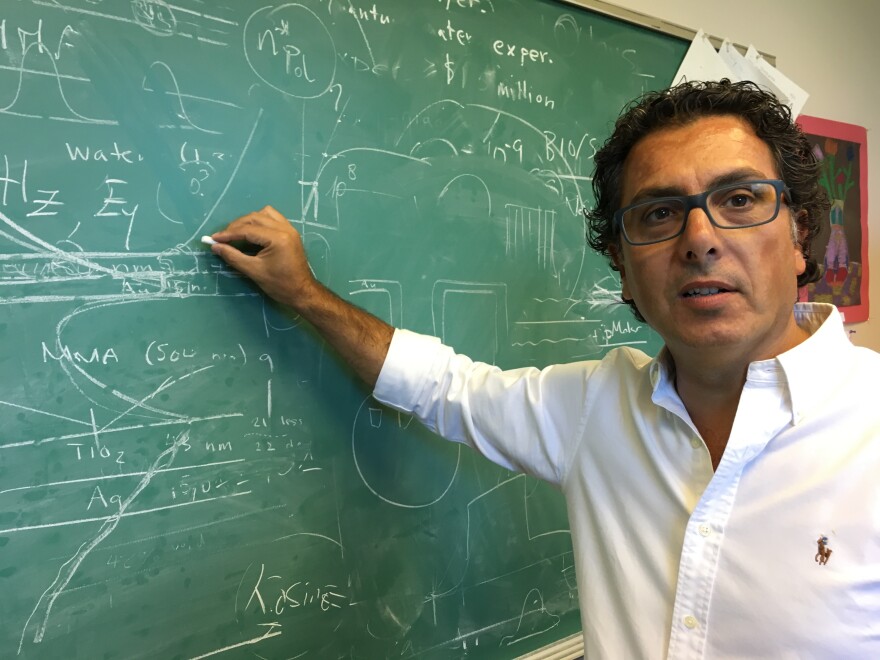Researchers in Cleveland have come up with a new biosensor that’s a million times more sensitive than current technology.
In this week’s Exploradio, WKSU’s Jeff St.Clair looks at how harnessing one of the unusual properties of gold has allowed for a quantum leap forward.
First of all – a biosensor is a something that detects small amounts of a biological chemical – your nose is a good example. You inhale a molecule, it lands on a receptor inside your nose which sends a signal to your brain. For example, a skunk sprayed your neighbor’s dog – small molecule detected!
Now, to give you a sense of the jump in sensitivity in the biosensor being developed at Case Western Reserve University, consider your nose compared to a dog’s nose.
His is around 10,000 times more sensitive than yours, and that’s a lot. Meanwhile, the new biosensor is 1 million times more sensitive than current detectors.

And it can detect super small molecules.
Reaching super-sensitivity
Physicist Giuseppe Strangi led the team that developed the biosensor.
His device sees concentrations not on the micro scale, or even nano:
“We are talking femto scale. It means one millionth of a billionth,” says Strangi.
It can sense better than the best bloodhound.
“We can detect almost a single molecule," he says.
The question is… how?
Overcoming limits of diffraction and diffusion
It turns out that Strangi and his team had to overcome two principles of physics to achieve their impressive sensitivity.
Strangi says the sensor uses light to analyze samples, but in a unique way.
The problem is, if you want to see very small things like molecules, light waves are too big. You can’t see something smaller than the wavelength of light. It’s called the diffraction limit.

That’s the first hurdle.
The second challenge was getting a tiny molecule to find its way to his sensor. Molecules like to bounce around - they’re not subject to gravity - so it’s hard to get them to land where you want.
That’s called the diffusion limit.
Strangi had to overcome both to get his device to work.
First we’ll tackle the wavelength problem – the diffraction limit.
Harnessing plasmonics
Strangi took advantage of one the remarkable properties of nano layers of gold.
It turns out that the electrons inside an ultrathin layer of gold move in a vibrating wave when hit by a beam of light.
Strangi says it’s a relatively new branch of physics, "the concept is called plasmonics.”
And the plasmonic field formed by the vibrating electrons on the tiny layer of gold can see things much smaller than the wavelength of light.
“So whatever molecule will land on top of that, these electrons will see that.”
Strangi’s sensor is made up of 16 layers of gold, just a few hundred atoms thick, sandwiched between layers of Aluminum Oxide. Together it’s called a metamaterial.
This creates a much denser plasmonic field which gives his sensor extraordinary sensitivity.
We visit the lab to see how the team overcame the other challenge, the diffusion limit.
Small scale physics

Doctoral student Mohamed ElKabbash shows me an unassuming centimeter sized chip topped with a tiny plastic box.
“As you can see there’s a microfluidic channel on top of a material slab, this is basically glass with a very thin film on top of it,” says ElKabbash.
The goldish-green sheen on the glass is the magical metamaterial. The tiny plastic box with tubes at each end allows it to work.
ElKabbash explains that this microfluidic channel corrals the molecule onto the surface of the sensor through a special hydrophobic, or 'water-hating surface', while a chemical binder holds it there.
“And once it reaches the surface," says ElKabbash, "our metamaterial does it work.”
The plasmonic field ‘sees’ it and a graph shows the size and concentration of the molecule in question based on the shift in reflected light bouncing off the sensor.

Sensing cancer on the femto scale
At the Cleveland Clinic, cancer researcher Dr. Nima Sharifi lists some of the molecules he’d like to use the sensor to screen for.
“It could be a protein, it could be DNA or RNA, it could be detection of circulating tumor cells,” he says.
Sharifi is working with physicist Strangi and his team to refine the biosensor in treating cancer.
He says while the biosensor will help with early detection, what’s really needed is a way to monitor subtle changes in cancer tissue that’s being treated but not going away.
Sharifi says Strangi’s biosensor will also allow him to read the output of specific cancer causing genes.
“So detecting aberrant vs normal protein in this particular context is one of the tremendous potentials of this type of technology,” says Sharifi.
The new biosensor is still years away from commercial production but Case Western’s Giuseppe Strangi says it has been patented and work is being done to move it out of the lab and into the clinic.








